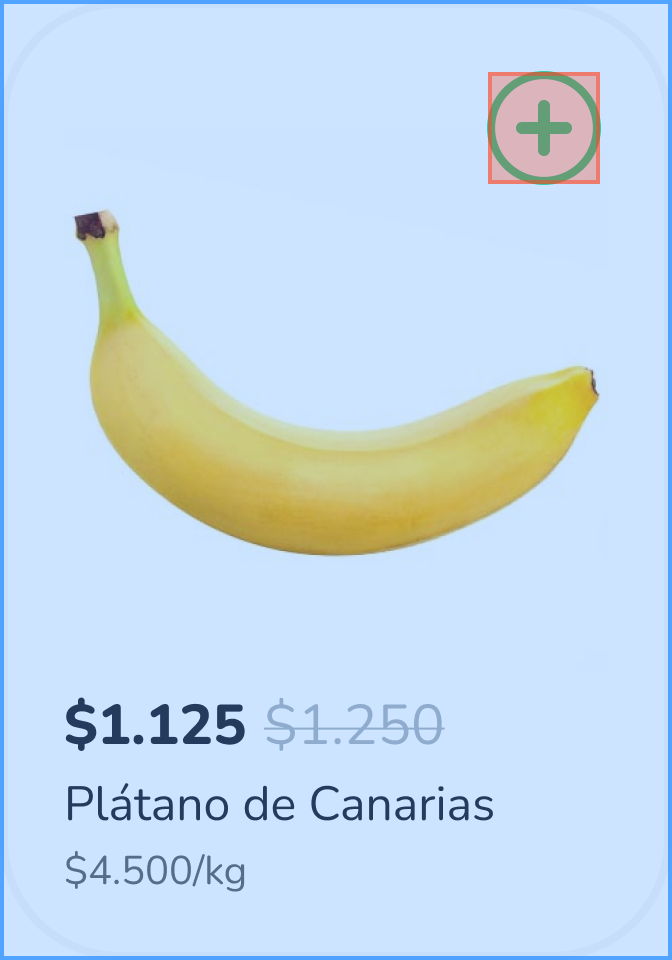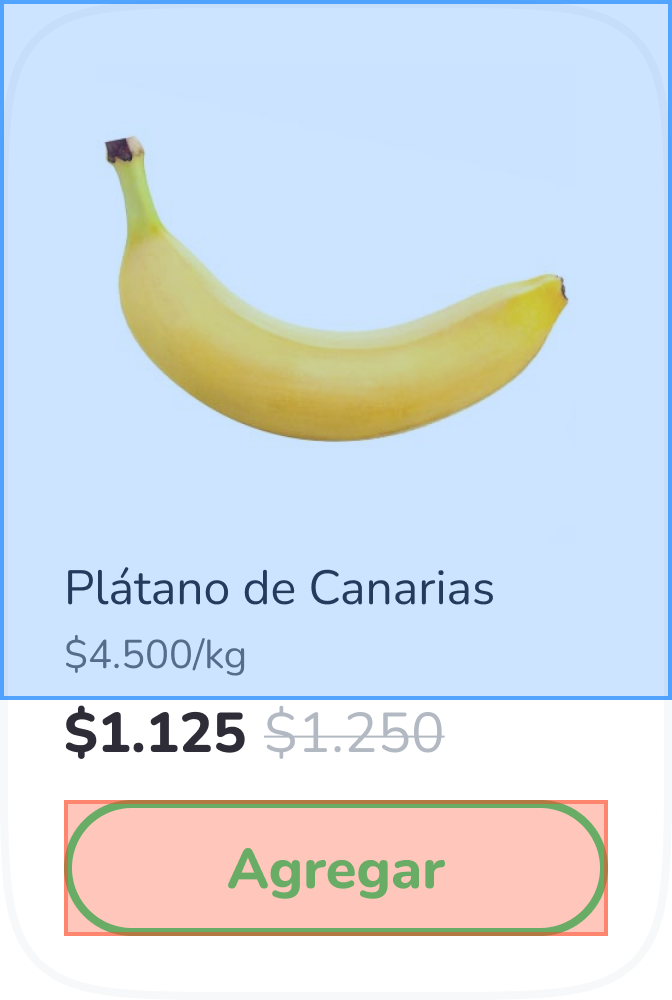In this project I designed a new version of the Add to Cart button (ATC) for the groceries experience at Rappi.
New Add to Cart
Introduction.
This is one of the projects I led to improve the experience of our users during their purchase process. In this case I focused on improving the UX in terms of usability, analyzing the 3 most important KPI's in a delivery experience.
Role
Design Leader
Date
May 18, 2021
Category
Product Design
TAGS
Usability
Old design
New design
UI Design.
Wrong button position
By having the button on top of the product itself, users experience a lot of missclicks during their purchase.
The product card has 2 events:
1. Open the product detail.
2. Add the product to the cart.
What is happening is that on many occasions the user is wanting to add a product to the cart, but is unintentionally touching the area that opens the product detail screen. This generates a lot of cognitive friction and becomes a serious usability problem when it is repeated several times during the purchase process, as it considerably increases the total time spent.

Old design

New design
With the new location of the ATC button, we can protect and separate correctly the zones of the 2 events. This way we help the user not to commit missclicks that generate friction during the experience.
Undersized
The size of the button is too small (32px) for the importance it has in the conversion. I always recommend following the best practices for this type of buttons, which should be finger-friendly (44px) to ensure that the user touches the button without problems and not elsewhere.
It may seem a simple detail, but designing according to Fitts' law improves the UX of this action, since we optimize its effectiveness and efficiency when carrying it out.
Usability.
01
Taps / Clicks
required to complete a given task.
02
Screens / States
that you have to go through during the execution of a task.
03
Time
that must be invested to complete a task.
KPIs definition
To properly address the phase of the project where I evaluate the usability of the designs, the first thing I do is to define what are the most important KPIs in the experience I'm working on.
In this case, during an online purchase in groceries, there are 3 KPIs of extremely high importance to determine the overall user experience.
Once we have the KPIs we are going to analyze, we can move on to perform a heuristic evaluation to make a comparison between the design we are trying to improve and the new solution. In this way we can quantitatively demonstrate which of them is better in terms of usability.
Heuristic evaluation
In this heuristic evaluation we must identify the tasks in which we can measure the KPIs that we have previously defined. In this way we will be able to build graphs and comparatives between the design we want to improve and the new solution.
To better understand this, I drop below as an example a comparison of the 3 KPI's with a very recurrent task during online shopping: Modify the units of a product.
Taps / Clicks
Screens / States
Time (seconds)
Data analysis.
Defining events
The next step is to analyze the entire experience where those indicators enter the playing field.
At this point we must find the events with which we can measure the previously mentioned KPIs, which in this case are:
01
Add units
Example: From 2 uds. → 3 uds.
02
Delete units
Example: From 4 uds. → 2 uds.
03
Remove product
Example: From 1 ud. → 0 uds.
Once we have that, all that's left is to build the Amplitude queries we need to access the data.
Massive analysis
At Rappi we have more than 50 million active users, so we have at our fingertips a huge amount of real and valuable data with which to validate our design decisions.
In this case with Amplitude and some mathematical calculations I got the following data:
All changes in product units in the last 30 days|
Modification → Delete units
Modification → Add units
Taps / Clicks
Screens / States
Time (hours)
Guerrilla testing.
Test plan
To qualitatively validate this project I decided to include some guerilla tests, because despite having a great general impact, it is a design change that affects a very specific task: Adding and removing products to the cart.
The scenarios and tasks were as follows:
feedback #1
Ignacio, 29 (Argentina)
" I could not easily remove the Coke."
"I found this design more comfortable. "
"The button was too small. "
"The button is larger, which makes it easier for me to add and remove products. "
"The stepper opens and closes when you put the units on, and that makes it very difficult for me. "
"This design is clearer to me because the buttons are always accessible."
" I like the design but I find the other one more useful. "
feedback #2
Manuela, 26 (Argentina)
"I opened the product detail screen by mistake.
"It's much simpler this way. "
"Maybe the button is too small. "
"I can clearly see how many units I have. "
"I find it tedious that it is at the top. "
"I can add, I can remove... It's clearer. "
"I find it much neater visually. "
feedback #3
Paula, 25 (Brazil)
"Sometimes I can't modify units form the product card."
"I like it. If I did everything from the card itself it would help me more this design. "
I don't use the button, I usually open the product screen because the button is too small. "
In my case it wouldn't affect me much, but this design is more intuitive. "
"When I have to make a lot of modifications, I do them from the cart, the product card is very tedious and slow. "
feedback #4
Marina, 29 (Argentina)
"I opened the product detail screen by mistake.
"The fact that the buttons remain fixed makes it easier to use. "
"In my opinion the button is too small. "
"I like that the button is bigger. "
" I like this design visually but it's a bit tedious to use. "
"I find this design much more functional. "
"With this design, the problem of unintentionally opening the product screen didn't occur. "
Takeaway.
Sometimes it happens (especially in Agile environments) that we get into a dynamic in which we only focus on continuously releasing new projects and functionalities, but we forget to follow up on the designs that have already been implemented.
This is really important, because if we don't do this, we will be creating a product with a multitude of functionalities but increasingly difficult to use or even less useful for our users.
Another very important point is that no matter how small or basic a project may seem, it can have a huge impact on the product, as you have been able to see!